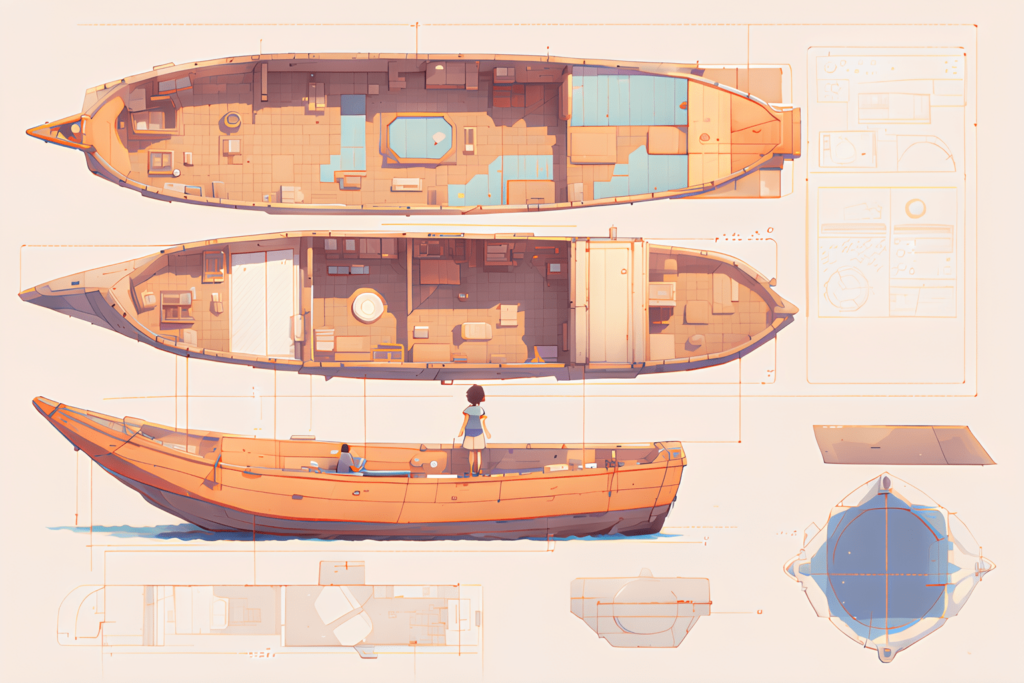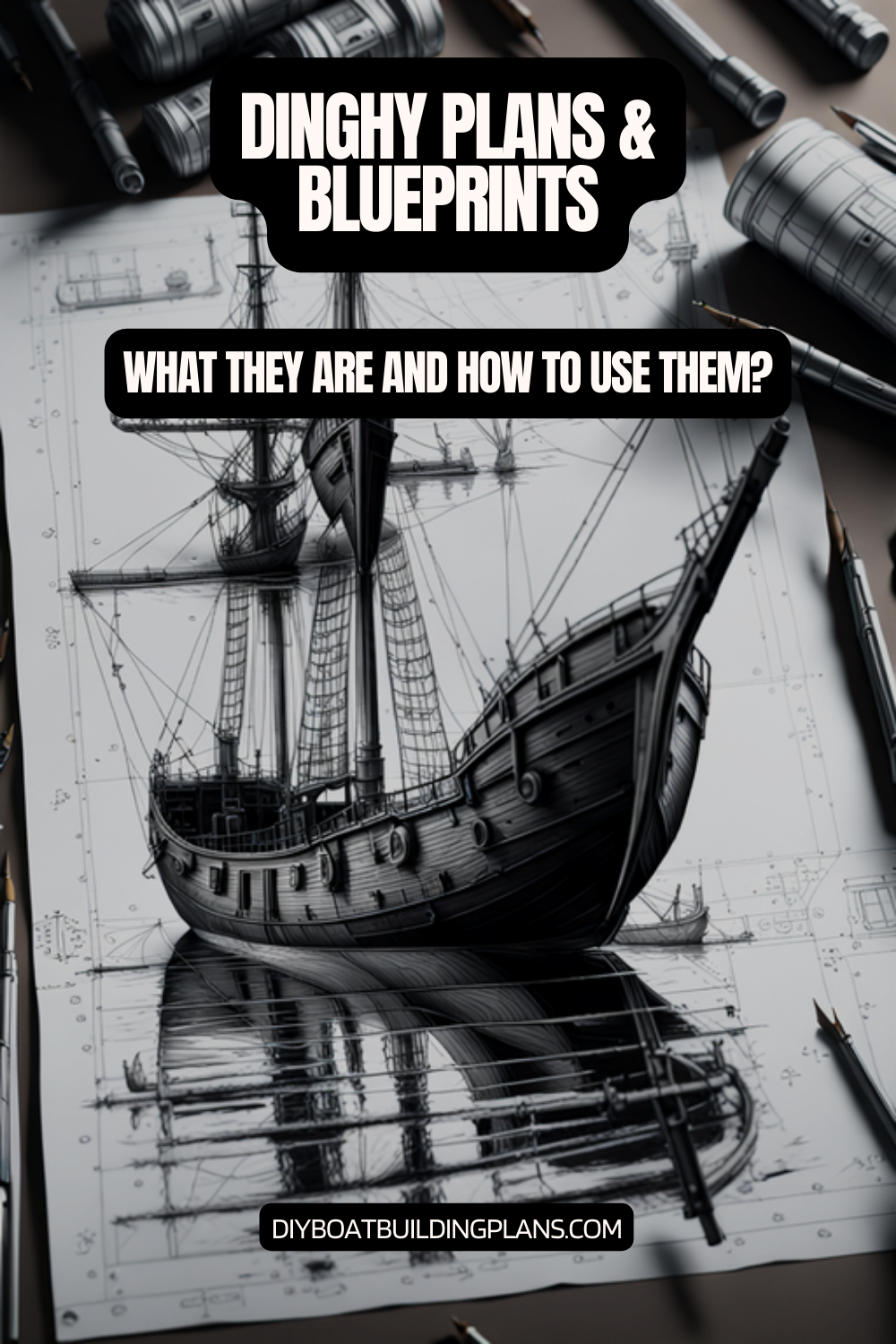Overview of Dinghy Plans & Blueprints
Dinghy plans and blueprints are essential tools for anyone looking to build their own dinghy. A dinghy is a small boat typically used for transportation or as a tender for larger vessels. Having a plan before starting the construction process is crucial as it provides a clear guide and ensures that the final product is accurate and precise.
Key Takeaways
- Dinghy plans and blueprints provide a detailed guide for building a dinghy.
- Using plans and blueprints can save time and money compared to designing a dinghy from scratch.
- There are different types of plans and blueprints available, including DIY and professional options.
- When choosing plans and blueprints, consider your skill level, budget, and intended use for the dinghy.
- Building a dinghy requires essential tools and materials, as well as careful attention to the plans and blueprints.

Benefits of Using Dinghy Plans & Blueprints
Using dinghy plans and blueprints offers several benefits. Firstly, it saves both time and money. With a well-designed plan, you can avoid costly mistakes and unnecessary trips to the hardware store. Additionally, having a blueprint to follow eliminates the need for trial and error, allowing you to complete the project more efficiently.
Furthermore, using plans and blueprints ensures accuracy and precision in the construction process. The detailed measurements and instructions provided in the plans guarantee that each component of the dinghy is built to the correct specifications. This not only enhances the overall appearance of the boat but also improves its performance on the water.
Types of Dinghy Plans & Blueprints Available
There are various types of dinghy plans and blueprints available to suit different needs and preferences. Free plans can be found online, offering a cost-effective option for those on a tight budget. These plans are often basic but can still provide a good starting point for beginners.
On the other hand, paid plans offer more comprehensive instructions and often include additional resources such as video tutorials or customer support. While they come at a price, these plans are usually well worth the investment for those seeking a more detailed guide.
Lastly, custom plans are tailored to specific requirements and preferences. These plans are ideal for individuals who have specific design ideas or unique needs for their dinghy.
Factors to Consider When Choosing Dinghy Plans & Blueprints
| Factors to Consider | Description |
|---|---|
| Size | The size of the dinghy should be appropriate for the intended use and the size of the boat it will be used with. |
| Material | The material used for the dinghy should be durable, lightweight, and suitable for the intended use. |
| Design | The design of the dinghy should be suitable for the intended use, such as rowing, sailing, or motoring. |
| Cost | The cost of the dinghy should be within the budget of the buyer and should provide good value for the money. |
| Availability of Plans & Blueprints | The availability of plans and blueprints for the dinghy should be considered, as this can affect the ease of construction and customization. |
| Experience Level | The experience level of the builder should be considered when choosing dinghy plans and blueprints, as some designs may be more complex than others. |
| Intended Use | The intended use of the dinghy should be considered, such as whether it will be used for fishing, recreation, or transportation. |
When selecting dinghy plans and blueprints, there are several factors to consider. Firstly, your skill level should be taken into account. If you are a beginner, it is advisable to choose plans that are suitable for beginners and provide clear instructions.
The type of dinghy you want to build is another important consideration. Different plans are available for various types of dinghies, such as rowing dinghies or sailing dinghies. Make sure to choose plans that align with your desired type of boat.
Budget is also a significant factor. Determine how much you are willing to spend on plans and blueprints, as well as the overall cost of materials and tools required for the construction process.
Lastly, consider the availability of materials in your area. Some plans may require specific types of wood or other materials that may not be readily accessible. Ensure that you can source the necessary materials before committing to a particular set of plans.
Top Dinghy Plans & Blueprints Providers
There are several reputable providers of dinghy plans and blueprints. Wooden Boat Plans offers a wide range of designs for different types of boats, including dinghies. Their plans are known for their attention to detail and clear instructions.
Bateau is another popular provider that offers both free and paid plans. They have a vast selection of designs, catering to various skill levels and preferences.
Glen-L is renowned for their high-quality boat plans, including dinghy designs. Their plans are well-regarded in the boating community for their accuracy and ease of use.
Spira International is a trusted source for boat plans, offering a variety of options for dinghies. Their plans are known for their simplicity and affordability.
Duckworks is a comprehensive resource for boat builders, providing an extensive collection of plans and blueprints. They offer designs for both traditional and modern-style dinghies.
How to Read and Interpret Dinghy Plans & Blueprints
Reading and interpreting dinghy plans and blueprints may seem daunting at first, but with some guidance, it becomes much easier. Understanding the symbols and measurements used in the plans is crucial. Take the time to familiarize yourself with the key symbols and their corresponding meanings.
Identifying the different parts of the dinghy is another important aspect. The plans will typically include labeled diagrams that indicate each component of the boat. Pay close attention to these labels to ensure accurate assembly.
Following the step-by-step instructions provided in the plans is essential for a successful build. Take your time to read through each instruction carefully before proceeding. It is also helpful to have a clear workspace and organize your materials before starting.
Essential Tools and Materials for Building a Dinghy
Building a dinghy requires specific tools and materials. Some essential tools include a saw, drill, chisels, clamps, and sandpaper. These tools will be used for cutting, shaping, and assembling the various components of the dinghy.
The type of materials required will depend on the specific plans chosen. Common materials include marine-grade plywood, epoxy resin, fiberglass cloth, and stainless steel fasteners. It is important to choose high-quality materials that are suitable for marine environments to ensure the longevity of your dinghy.
Safety equipment should not be overlooked. Safety goggles, gloves, and a dust mask are essential when working with power tools and chemicals.
Step-by-Step Guide to Building a Dinghy Using Plans & Blueprints
Building a dinghy using plans and blueprints can be broken down into several steps. Firstly, thorough preparation is necessary. This includes gathering all the required tools and materials, as well as setting up a suitable workspace.
Next, cutting and shaping the wood according to the dimensions provided in the plans is crucial. Take your time to ensure accurate cuts and smooth edges.
Assembling the parts of the dinghy is the next step. Follow the instructions provided in the plans carefully, ensuring that each component is securely attached.
Lastly, add the finishing touches to your dinghy. This may include sanding any rough edges, applying a protective coating, or adding any desired features or accessories.
Common Mistakes to Avoid When Building a Dinghy
There are several common mistakes that should be avoided when building a dinghy. Firstly, not following the plans correctly can lead to errors in the construction process. It is important to carefully read and understand each instruction before proceeding.
Rushing the process is another mistake to avoid. Building a dinghy requires patience and attention to detail. Take your time to ensure each step is completed accurately.
Using the wrong materials can also lead to problems down the line. Make sure to choose materials that are suitable for marine environments and follow the recommendations provided in the plans.
Download over 500 Boat Plans. Click on the link below.
-->Click Here<--
Maintenance and Repair of a Dinghy
Once your dinghy is built, regular maintenance is necessary to keep it in good condition. Regular cleaning and upkeep, such as washing off saltwater and inspecting for any damage, should be performed after each use.
Common repairs may include patching small holes or cracks, replacing worn-out hardware, or refinishing the wood. It is important to address any issues promptly to prevent further damage.
In some cases, seeking professional help may be necessary for more complex repairs or maintenance tasks. Professional boatyards or marine technicians can provide expert advice and assistance when needed.

Conclusion – Dinghy Plans & Blueprints
In conclusion, dinghy plans and blueprints are invaluable resources for anyone looking to build their own dinghy. They save time and money, ensure accuracy and precision, and provide a clear guide throughout the construction process.
When choosing plans and blueprints, consider factors such as skill level, type of dinghy, budget, and availability of materials. Reputable providers such as Wooden Boat Plans, Bateau, Glen-L, Spira International, and Duckworks offer a wide range of options to suit different needs.
Reading and interpreting plans requires understanding symbols, identifying different parts, and following step-by-step instructions. Essential tools and materials, as well as safety equipment, are necessary for the construction process.
By following a step-by-step guide and avoiding common mistakes, you can successfully build your own dinghy. Regular maintenance and prompt repairs will ensure the longevity of your dinghy, allowing you to enjoy many adventures on the water.
FAQs – Dinghy Plans & Blueprints
What are dinghy plans and blueprints?
Dinghy plans and blueprints are detailed instructions and diagrams that guide boat builders in constructing a small, open sailboat called a dinghy.
What materials are needed to build a dinghy?
The materials needed to build a dinghy include marine-grade plywood, epoxy resin, fiberglass cloth, marine-grade paint, and various hardware such as screws, bolts, and hinges.
Do I need to have experience in boat building to use dinghy plans and blueprints?
While some experience in woodworking and boat building is helpful, many dinghy plans and blueprints are designed for beginners and include step-by-step instructions and diagrams.
Can I customize the design of my dinghy using plans and blueprints?
Yes, many dinghy plans and blueprints allow for customization of the design, including modifications to the size, shape, and features of the boat.
What tools are needed to build a dinghy?
The tools needed to build a dinghy include a saw, drill, jigsaw, sander, clamps, and various hand tools such as screwdrivers and pliers.
How long does it take to build a dinghy?
The time it takes to build a dinghy varies depending on the complexity of the design and the builder’s experience level. Some dinghies can be built in a few weeks, while others may take several months.
What is the cost of building a dinghy using plans and blueprints?
The cost of building a dinghy using plans and blueprints varies depending on the materials used and the size and complexity of the design. However, building a dinghy using plans and blueprints is generally less expensive than purchasing a pre-built dinghy.



